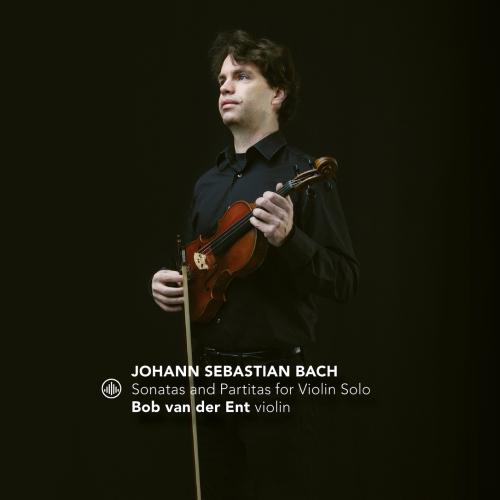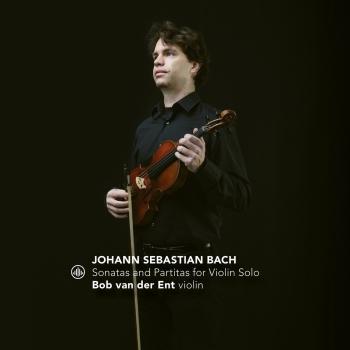
Sonatas and Partitas for Violin Solo Bob van der Ent
Album Info
Album Veröffentlichung:
2021
HRA-Veröffentlichung:
19.03.2021
Label: Challenge Classics
Genre: Classical
Subgenre: Instrumental
Interpret: Bob van der Ent
Komponist: Johann Sebastian Bach (1685-1750)
Das Album enthält Albumcover
- Johann Sebastian Bach (1685 - 1750): Violin Sonata No.1 in G Minor, BWV 1001:
- 1 Violin Sonata No.1 in G Minor, BWV 1001: I. Adagio 04:07
- 2 Violin Sonata No.1 in G Minor, BWV 1001: II. Fuga 05:44
- 3 Violin Sonata No.1 in G Minor, BWV 1001: III. Siciliana 03:16
- 4 Violin Sonata No.1 in G Minor, BWV 1001: IV. Presto 03:42
- Violin Partita No.1 in B Minor, BWV 1002:
- 5 Violin Partita No.1 in B Minor, BWV 1002: I. Allemanda 05:37
- 6 Violin Partita No.1 in B Minor, BWV 1002: II. Double 03:20
- 7 Violin Partita No.1 in B Minor, BWV 1002: III. Courante 03:39
- 8 Violin Partita No.1 in B Minor, BWV 1002: IV. Double 04:00
- 9 Violin Partita No.1 in B Minor, BWV 1002: V. Sarabande 03:53
- 10 Violin Partita No.1 in B Minor, BWV 1002: VI. Double 02:24
- 11 Violin Partita No.1 in B Minor, BWV 1002: VII. Tempo di Bourrée 03:25
- 12 Violin Partita No.1 in B Minor, BWV 1002: VIII. Double 03:11
- Violin Sonata No.2 in A Minor, BWV 1003:
- 13 Violin Sonata No.2 in A Minor, BWV 1003: I. Grave 04:22
- 14 Violin Sonata No.2 in A Minor, BWV 1003: II. Fuga 08:03
- 15 Violin Sonata No.2 in A Minor, BWV 1003: III. Andante 05:38
- 16 Violin Sonata No.2 in A Minor, BWV 1003: IV. Allegro 06:04
- Violin Sonata No.3 in C Major, BWV 1005:
- 17 Violin Sonata No.3 in C Major, BWV 1005: I. Adagio 04:31
- 18 Violin Sonata No.3 in C Major, BWV 1005: II. Fuga 10:56
- 19 Violin Sonata No.3 in C Major, BWV 1005: III. Largo 03:16
- 20 Violin Sonata No.3 in C Major, BWV 1005: IV. Allegro assai 05:16
- Violin Partita No.2 in D Minor, BWV 1004:
- 21 Violin Partita No.2 in D Minor, BWV 1004: I. Allemande 04:46
- 22 Violin Partita No.2 in D Minor, BWV 1004: II. Courante 02:52
- 23 Violin Partita No.2 in D Minor, BWV 1004: III. Sarabande 04:02
- 24 Violin Partita No.2 in D Minor, BWV 1004: IV. Gigue 04:33
- 25 Violin Partita No.2 in D Minor, BWV 1004: V. Chaconne 14:52
- Violin Partita No.3 in E Major, BWV 1006:
- 26 Violin Partita No.3 in E Major, BWV 1006: I. Preludio 03:48
- 27 Violin Partita No.3 in E Major, BWV 1006: II. Loure 03:58
- 28 Violin Partita No.3 in E Major, BWV 1006: III. Gavotte en Rondeau 02:58
- 29 Violin Partita No.3 in E Major, BWV 1006: IV. Menuett I & V. Menuett II 03:57
- 30 Violin Partita No.3 in E Major, BWV 1006: VI. Bourrée 01:32
- 31 Violin Partita No.3 in E Major, BWV 1006: VII. Gigue 01:58
Info zu Sonatas and Partitas for Violin Solo
It was not until I picked up my violin and played a few movements of solo Bach, one winter's evening at home, that the essence of the composer finally permeated my being. I felt an almost mystical unity with the music that I'd never experienced before. Because there are already so many fabulous recordings of Bach, I asked myself "What can I still add to this?" What surprised me, however, was that the wide diversity of approach was actually a great source of inspiration to me rather than being in any way off-putting. Apparently, the possibilities of Bach's music are inexhaustible. This is what gave me the courage I needed to issue a new recording.
To me, the narrative power of Bach's music means that it can sound like new in every era and in every performance. People's opinions of Bach are constantly changing and will continue to do so in the future. My recording of Bach is an interpretation of my vision of his music up until now, and I have striven for authenticity by remaining true to my personal vision, without making it a predominant feature.
For years now, I have been playing a violin that is very dear to me; an instrument by Jean Baptiste Vuillaume from 1828. It is modelled after Stradivarius and its tonal design is typical of 18th century instruments, with a wide palette of colours. Using gut strings on this instrument, especially for Bach, adds a great deal of clarity to the sound, a richer range of overtones and a warmer sound that more closely approximates the human voice. Finally, a Baroque bow offers many more options for the expression I'm seeking. It's a bow that feels like a fine paintbrush, helping me to paint the music, as it were, in great detail.
Bob van der Ent, violin
Bob van der Ent (1982)
began his violin studies with Lauri Vreeken-Bos at the age of five and subsequently studied with Jan Repko, Davina van Wely and Herman Krebbers.
In 1993 he was one of the first students admitted to the special Young Talent Department at the Conservatory of Amsterdam, where he graduated in 2006 with Vesko Eschkenazy, leader of the Royal Concertgebouw Orchestra. He followed master classes with renowned violinists such as a.o. Lorand Fennyves, Eduard Grach, Shmuel Ashkenazy (primarius of the Vermeer Quartet), Ivry Gitlis and Pierre Amoyal.
Since his debut, at the age of 10, as soloist with the Dutch Youth String Orchestra under the guidance of Roland Kieft, he has worked as a soloist with many orchestras. In 2005 he made his debut in the main hall of the Concertgebouw in Amsterdam under the guidance of Jurjen Hempel.
Van der Ent has received numerous prizes on a national and international level.
In 1996 he won the first prize at the Iordens Viooldagen (the national violin competition for young violinists), and at the Princess Christina Concours (1999).
In 2000 he achieved the Diplôme d’Honneur at the famous International Wieniawsky- Lipinsky Competition in Poland and in 2005 he was prize winner at the National Violin Competition Oskar Back.
In 1995 he gave his first recital and he performed in renowned halls such as the Concertgebouw, Muziekcentrum Vredenburg (Utrecht), the Doelen (Rotterdam) etc., and in Belgium, France, Austria, Switzerland, Portugal, Russia and the United States. Van der Ent also performed for radio and television. He continues to provide his assistance to the Royal Concertgebouw Orchestra on a regular basis.
Dieses Album enthält kein Booklet













